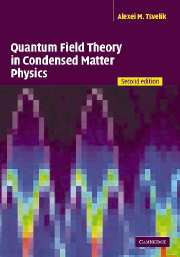Book contents
- Frontmatter
- Contents
- Preface to the first edition
- Preface to the second edition
- Acknowledgements for the first edition
- Acknowledgements for the second edition
- I Introduction to methods
- II Fermions
- 11 Path integral and Wick's theorem for fermions
- 12 Interacting electrons: the Fermi liquid
- 13 Electrodynamics in metals
- 14 Relativistic fermions: aspects of quantum electrodynamics
- 15 Aharonov–Bohm effect and transmutation of statistics
- III Strongly fluctuating spin systems
- IV Physics in the world of one spatial dimension
- Select bibliography
- Index
13 - Electrodynamics in metals
Published online by Cambridge University Press: 05 May 2010
- Frontmatter
- Contents
- Preface to the first edition
- Preface to the second edition
- Acknowledgements for the first edition
- Acknowledgements for the second edition
- I Introduction to methods
- II Fermions
- 11 Path integral and Wick's theorem for fermions
- 12 Interacting electrons: the Fermi liquid
- 13 Electrodynamics in metals
- 14 Relativistic fermions: aspects of quantum electrodynamics
- 15 Aharonov–Bohm effect and transmutation of statistics
- III Strongly fluctuating spin systems
- IV Physics in the world of one spatial dimension
- Select bibliography
- Index
Summary
The possiblity of a violation of Fermi liquid theory remains one of the most intriguing problems in condensed matter theory. One loophole in the Landau reasoning is easy to find – in the derivation of decay rate given in the previous chapter I assumed that the effective interaction U is weakly momentum dependent. If this is not the case and U(k) is singular at |k| → 0, the decay rate will not be that small at the Fermi surface. Strong momentum dependence corresponds to long distance interactions; hence the presence of such interactions makes the Landau theory inapplicable. The problem is where to get such interactions. It appears that the electrostatic (Coulomb) interaction will do the job. This is a vain hope, however, because the Coulomb force is long distance only in vacuum and in insulators; in metals conduction electrons screen the Coulomb interaction and make it effectively short range. The interaction which remains long distance in metals is a much weaker interaction of electronic currents via the exchange of transverse photons. The fact that this interaction may lead to violations of the Fermi liquid theory was discovered by Holstein et al. (1973), but the real interest in this fact arose after the papers by Reizer (1989, 1991). Since photons are everywhere, this interaction exists in any metal. However, since the current–current interaction is proportional to the square of the ratio of the Fermi velocity to the speed of light, the corresponding bare coupling constant is small. As we shall see, deviations from the Fermi liquid theory may become noticeable only at very low temperatures and only provided the metal is very pure.
- Type
- Chapter
- Information
- Quantum Field Theory in Condensed Matter Physics , pp. 103 - 118Publisher: Cambridge University PressPrint publication year: 2003

